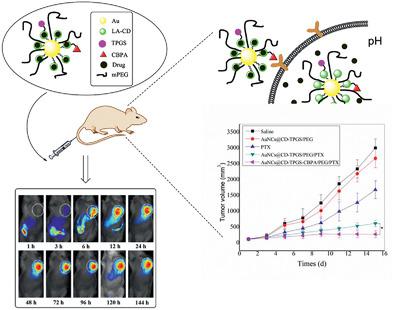当前位置:
X-MOL 学术
›
Part. Part. Syst. Charact.
›
论文详情
Our official English website, www.x-mol.net, welcomes your feedback! (Note: you will need to create a separate account there.)
Targeted and Specific Modification with 4‐Carboxybenzeneboronic Acid and TPGS of Fluorescent Gold Nanoparticles and the Enhanced Antitumor Activity Research
Particle & Particle Systems Characterization ( IF 2.7 ) Pub Date : 2021-03-07 , DOI: 10.1002/ppsc.202000333 Qiaoqiao Zhou 1 , Shaochen Wang 1 , Peng Hu 1 , Shuling Yu 1 , Jiahua Shi 1 , Jintao Yuan 2
Particle & Particle Systems Characterization ( IF 2.7 ) Pub Date : 2021-03-07 , DOI: 10.1002/ppsc.202000333 Qiaoqiao Zhou 1 , Shaochen Wang 1 , Peng Hu 1 , Shuling Yu 1 , Jiahua Shi 1 , Jintao Yuan 2
Affiliation

|
A targeting and specific fluorescent gold nanoparticle is prepared for tracing of drug and effective treatment of cancers. First, 4‐carboxybenzeneboronic acid (CBPA) and D‐α‐tocopheryl polyethylene glycol 1000 succinate (TPGS) are used to modify cyclodextrins (CDs), then modified cyclodextrins and polyethylene glycol (PEG) are used to stabilize gold nanoclusters to prepare fluorescent gold nanoparticles (AuNCs@CD‐TPGS‐CBPA/PEG). CBPA has targeting and TPGS can induce apoptosis, therefore, AuNCs@CD‐TPGS‐CBPA/PEG has targeting and certain anti‐tumor activity. The structure and morphology of the nanomaterial are characterized by using nuclear magnetic resonance (NMR) spectroscopy and transmission electron microscope (TEM). Paclitaxel (PTX) is loaded into the hydrophobic cavity of CDs to form targeting specific drug‐loaded fluorescent gold nanoparticles (AuNCs@CD‐TPGS‐CBPA/PEG/PTX). Biological performances of AuNCs@CD‐TPGS‐CBPA/PEG are studied by in vitro and in vivo experiments. In vitro test results confirm that AuNCs@CD‐TPGS‐CBPA/PEG could be internalized by tumor cells, and effectively against tumor cells, but it is biocompatible to normal cells. In vivo experiments prove that AuNCs@CD‐TPGS‐CBPA/PEG has excellent targeting, biocompatibility, and enhanced antitumor capability, could enrich and stay for a long time in the tumor regions, effectively prolong the lifetime of tumor‐bearing mice. Therefore, this work provides an insight into the development of fluorescent gold nanomaterials for practical biomedical application.
中文翻译:

荧光金纳米粒子的4-羧基苯硼酸和TPGS的靶向和特异性修饰及增强的抗肿瘤活性研究
制备了靶向性和特异性荧光金纳米颗粒,用于药物追踪和有效治疗癌症。首先,使用4-羧基苯硼酸(CBPA)和D-α-生育酚聚乙二醇1000琥珀酸酯(TPGS)修饰环糊精(CD),然后使用修饰的环糊精和聚乙二醇(PEG)稳定金纳米团簇以制备荧光金纳米粒子(AuNCs @ CD‐TPGS‐CBPA / PEG)。CBPA具有靶向作用,TPGS可以诱导凋亡,因此,AuNCs @ CD‐TPGS‐CBPA / PEG具有靶向作用并具有一定的抗肿瘤活性。通过使用核磁共振(NMR)光谱和透射电子显微镜(TEM)表征纳米材料的结构和形态。将紫杉醇(PTX)装入CD的疏水腔中,以形成靶向特定药物的荧光金纳米颗粒(AuNCs @ CD-TPGS-CBPA / PEG / PTX)。通过体外和体内实验研究了AuNCs @ CD‐TPGS‐CBPA / PEG的生物学性能。体外测试结果证实AuNCs @ CD‐TPGS‐CBPA / PEG可以被肿瘤细胞内化,并有效对抗肿瘤细胞,但与正常细胞具有生物相容性。体内实验证明,AuNCs @ CD‐TPGS‐CBPA / PEG具有出色的靶向性,生物相容性和增强的抗肿瘤能力,可以在肿瘤区域富集并长期保留,有效地延长了荷瘤小鼠的寿命。因此,这项工作为实际生物医学应用的荧光金纳米材料的发展提供了见识。通过体外和体内实验研究了AuNCs @ CD‐TPGS‐CBPA / PEG的生物学性能。体外测试结果证实AuNCs @ CD‐TPGS‐CBPA / PEG可以被肿瘤细胞内化,并有效对抗肿瘤细胞,但与正常细胞具有生物相容性。体内实验证明,AuNCs @ CD‐TPGS‐CBPA / PEG具有出色的靶向性,生物相容性和增强的抗肿瘤能力,可以在肿瘤区域富集并长期保留,有效地延长了荷瘤小鼠的寿命。因此,这项工作为实际生物医学应用的荧光金纳米材料的发展提供了见识。通过体外和体内实验研究了AuNCs @ CD‐TPGS‐CBPA / PEG的生物学性能。体外测试结果证实AuNCs @ CD‐TPGS‐CBPA / PEG可以被肿瘤细胞内化,并有效对抗肿瘤细胞,但与正常细胞具有生物相容性。体内实验证明,AuNCs @ CD‐TPGS‐CBPA / PEG具有出色的靶向性,生物相容性和增强的抗肿瘤能力,可以在肿瘤区域富集并长期保留,有效地延长了荷瘤小鼠的寿命。因此,这项工作为实际生物医学应用的荧光金纳米材料的发展提供了见识。并有效对抗肿瘤细胞,但与正常细胞具有生物相容性。体内实验证明,AuNCs @ CD‐TPGS‐CBPA / PEG具有出色的靶向性,生物相容性和增强的抗肿瘤能力,可以在肿瘤区域富集并长期保留,有效地延长了荷瘤小鼠的寿命。因此,这项工作为实际生物医学应用的荧光金纳米材料的发展提供了见识。并有效对抗肿瘤细胞,但与正常细胞具有生物相容性。体内实验证明,AuNCs @ CD‐TPGS‐CBPA / PEG具有出色的靶向性,生物相容性和增强的抗肿瘤能力,可以在肿瘤区域富集并长期保留,有效地延长了荷瘤小鼠的寿命。因此,这项工作为实际生物医学应用的荧光金纳米材料的发展提供了见识。
更新日期:2021-04-19
中文翻译:

荧光金纳米粒子的4-羧基苯硼酸和TPGS的靶向和特异性修饰及增强的抗肿瘤活性研究
制备了靶向性和特异性荧光金纳米颗粒,用于药物追踪和有效治疗癌症。首先,使用4-羧基苯硼酸(CBPA)和D-α-生育酚聚乙二醇1000琥珀酸酯(TPGS)修饰环糊精(CD),然后使用修饰的环糊精和聚乙二醇(PEG)稳定金纳米团簇以制备荧光金纳米粒子(AuNCs @ CD‐TPGS‐CBPA / PEG)。CBPA具有靶向作用,TPGS可以诱导凋亡,因此,AuNCs @ CD‐TPGS‐CBPA / PEG具有靶向作用并具有一定的抗肿瘤活性。通过使用核磁共振(NMR)光谱和透射电子显微镜(TEM)表征纳米材料的结构和形态。将紫杉醇(PTX)装入CD的疏水腔中,以形成靶向特定药物的荧光金纳米颗粒(AuNCs @ CD-TPGS-CBPA / PEG / PTX)。通过体外和体内实验研究了AuNCs @ CD‐TPGS‐CBPA / PEG的生物学性能。体外测试结果证实AuNCs @ CD‐TPGS‐CBPA / PEG可以被肿瘤细胞内化,并有效对抗肿瘤细胞,但与正常细胞具有生物相容性。体内实验证明,AuNCs @ CD‐TPGS‐CBPA / PEG具有出色的靶向性,生物相容性和增强的抗肿瘤能力,可以在肿瘤区域富集并长期保留,有效地延长了荷瘤小鼠的寿命。因此,这项工作为实际生物医学应用的荧光金纳米材料的发展提供了见识。通过体外和体内实验研究了AuNCs @ CD‐TPGS‐CBPA / PEG的生物学性能。体外测试结果证实AuNCs @ CD‐TPGS‐CBPA / PEG可以被肿瘤细胞内化,并有效对抗肿瘤细胞,但与正常细胞具有生物相容性。体内实验证明,AuNCs @ CD‐TPGS‐CBPA / PEG具有出色的靶向性,生物相容性和增强的抗肿瘤能力,可以在肿瘤区域富集并长期保留,有效地延长了荷瘤小鼠的寿命。因此,这项工作为实际生物医学应用的荧光金纳米材料的发展提供了见识。通过体外和体内实验研究了AuNCs @ CD‐TPGS‐CBPA / PEG的生物学性能。体外测试结果证实AuNCs @ CD‐TPGS‐CBPA / PEG可以被肿瘤细胞内化,并有效对抗肿瘤细胞,但与正常细胞具有生物相容性。体内实验证明,AuNCs @ CD‐TPGS‐CBPA / PEG具有出色的靶向性,生物相容性和增强的抗肿瘤能力,可以在肿瘤区域富集并长期保留,有效地延长了荷瘤小鼠的寿命。因此,这项工作为实际生物医学应用的荧光金纳米材料的发展提供了见识。并有效对抗肿瘤细胞,但与正常细胞具有生物相容性。体内实验证明,AuNCs @ CD‐TPGS‐CBPA / PEG具有出色的靶向性,生物相容性和增强的抗肿瘤能力,可以在肿瘤区域富集并长期保留,有效地延长了荷瘤小鼠的寿命。因此,这项工作为实际生物医学应用的荧光金纳米材料的发展提供了见识。并有效对抗肿瘤细胞,但与正常细胞具有生物相容性。体内实验证明,AuNCs @ CD‐TPGS‐CBPA / PEG具有出色的靶向性,生物相容性和增强的抗肿瘤能力,可以在肿瘤区域富集并长期保留,有效地延长了荷瘤小鼠的寿命。因此,这项工作为实际生物医学应用的荧光金纳米材料的发展提供了见识。


























 京公网安备 11010802027423号
京公网安备 11010802027423号